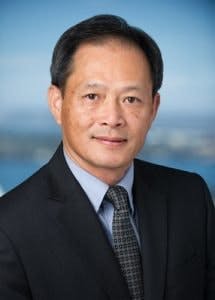Getting the Most Out of Microgrids: Strategies, Tools & Technologies to Reap Societal Benefits
What strategies and tools can help microgrids reap benefits, including societal, financial and environmental gain?
Patrick Lee, president, PXiSE Energy Solutions.
Microgrid Knowledge recently sought perspective from some of the panelists who will be featured at Microgrid 2019: Shaping the New Electric Grid, May 14-16 in San Diego.
Patrick Lee, founder of PXiSE Energy Solutions, a subsidiary of Sempra Energy, says that to deliver the biggest benefits, industry stakeholders need to move away from the focus on single microgrids and concentrate on interconnected microgrids that would yield benefits to society, the grid and customers.
The well-connected microgrid
“The overall benefits of interconnected microgrids can be viewed as the sum of benefits of individual microgrids. The focus of designing and delivering a maximum total benefit as a system would yield the most cost-effective solution for the society,” said Lee, who will speak Wednesday, May 15 on a panel: “Beyond Islanding: The Well-Connected Microgrid.”
Moderated by Ameresco’s Jacqueline DeRosa, the panel also includes Siemens’ Sacha Fontaine and NRG Energy’s Doug Sansom. Discussion will focus on the value of leveraging a microgrid’s connection — not only to each other but to the utility grid, which allows microgrids to sell energy, capacity and services back to the grid, arbitrage prices, manage renewable attributes, participate in demand response and engage in other revenue positive activities.
An interconnected microgrid can improve reliability, reduce energy costs and manage price volatility, Lee says. Additional advantages include optimizing the power delivery system, providing different levels of service quality and value to customers, and managing the intermittency of renewables. A network of microgrids would also help promote the deployment and integration of energy efficient and environmentally friendly technologies, Lee says.
Clean Coalition, another conference participant, also says networks of microgrids will deliver the biggest benefits, but sees numerous challenges.
Derisking microgrids
While Lee focuses on microgrid networks, Kati Sidwall, simulation specialist at RTDS Technologies, another featured panelist for the upcoming Microgrid 2019, concentrates on tools that help bring microgrid concepts to reality.
She says real-time simulation can provide important benefits to the microgrid industry and the grid. Sidwall will participate in a technology and engineering session on Tuesday, May 14, on the necessary steps to determine the feasibility of a microgrid. Moderated by ICF Consulting’s David Jones, the panel also includes Power Engineers’ Daniel Jones and Opal RT’s Syed Qaseem Ali.
“Our goal is to make people aware of real-time simulation as a tool that can support and even dramatically change the process for implementing grid modernization projects,” says Sidwall.
Originally created in the late 1980s, real-time simulation was initially used to test transmission-level protection and control. Traditionally, modeling tools have played a role in power systems analysis, equipment development and project implementation, she says.
“Traditionally, these programs run offline – they are software tools which run on the user’s PC to represent the behaviour of the grid. Events can be simulated in order to analyze system behaviours before (or after) they occur in the real world.”
But as the grid has evolved, real-time simulation has been used more for distribution applications.
“As real-time simulation becomes more commonly used by engineers to support microgrid, smart grid and non-wires automation projects, it is important for not only technology leaders, but also for policy and thought leaders, to be aware of the role it can play in shaping tomorrow’s grid,” she says.
Today, real-time simulation provides new opportunities for power engineers. It’s run on a custom-designed computer, operating at speeds fast enough to allow users to connect external equipment to the simulation.
Kati Sidwall, simulation specialist, RTDS Technologies.
“This means that centralized microgrid control systems, supervisory control and data acquisition (SCADA) systems, protective relays and local distributed energy controllers can be connected to the simulated microgrid.” These elements can be thoroughly tested before they are installed, says Sidwall.
With real-time simulation, engineers reduce risks associated with deploying new schemes or strategies. The tool boosts interoperability of devices, and improves the reliability, safety and efficiency of projects for all stakeholders, says Sidwall.
Sidwall hopes that attending Microgrid 2019 will give RTDS Technologies insight into emerging trends and standards in the microgrid community. RTDS can then consider these issues when developing its technology.
“I would also like to learn about specific design or deployment strategies taken in response to various technical challenges, as well as results,” says Sidwall.
The microgrid customer perspective
Another Tuesday, May 14 panel will take a deep dive into microgrid simulation from the customer’s perspective. Led by Typhoon Hil, a company that specializes in hardware-in-the-loop testing, the panel will offer perspective from EPC Power’s Ryan Smith, Schneider Electric’s Andy Haun, SEL’s Scott Manson, and Eaton’s Qiang Fu.
The multidisciplinary nature of the conference is a big plus, says Sidwall.
“We do so much work within the technical space, working with protection and control developers, utility engineers and researchers, and I’m really hoping a multidisciplinary conference like Microgrid 2019 will offer the chance to learn something from policy experts, regulators and advocates.”
Microgrid 2019 also will feature a workshop on microgrid policy, regulation and incentives and lively discussion about the microgrid market, the utility role, financing, technology innovation and real world microgrids for utilities, hospitals, campuses, urban development, commercial and industrial facilities, the military, tranportation, communities and even homes. Thursday, May 16 features tours of advanced microgrids at the University of California, San Diego and the Microgrid at the Marine Corps Air Station, Miramar.
Sponsored by Microgrid Knowledge, and now in its fourth year, Microgrid 2019 already has created a new record for number of sponsors and exhibitors.
The full Microgrid 2019 agenda is available here. The speaker roster is here. Register here.








